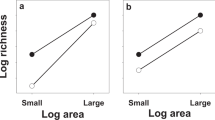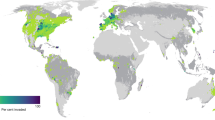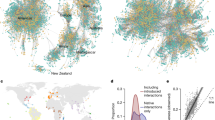Abstract
Biological invasions are a pervasive and costly environmental problem1,2 that has been the focus of intense management and research activities over the past half century. Yet accurate predictions of community susceptibility to invasion remain elusive. The diversity resistance hypothesis, which argues that diverse communities are highly competitive and readily resist invasion3,4,5, is supported by both theory6 and experimental studies7,8,9,10,11,12,13,14 conducted at small spatial scales. However, there is also convincing evidence that the relationship between the diversity of native and invading species is positive when measured at regional scales3,11,15,16. Although this latter relationship may arise from extrinsic factors, such as resource heterogeneity, that covary with diversity of native and invading species at large scales, the mechanisms conferring greater invasion resistance to diverse communities at local scales remain unknown. Using neighbourhood analyses, a technique from plant competition studies17,18,19, we show here that species diversity in small experimental grassland plots enhances invasion resistance by increasing crowding and species richness in localized plant neighbourhoods. Both the establishment (number of invaders) and success (proportion of invaders that are large) of invading plants are reduced. These results suggest that local biodiversity represents an important line of defence against the spread of invaders.
This is a preview of subscription content, access via your institution
Access options
Subscribe to this journal
Receive 51 print issues and online access
$199.00 per year
only $3.90 per issue
Buy this article
- Purchase on Springer Link
- Instant access to full article PDF
Prices may be subject to local taxes which are calculated during checkout



Similar content being viewed by others
References
Mooney, H. A. & Drake, J. A. Ecology of Biological Invasions of North America and Hawaii (Springer, New York, 1986)
Vitousek, P. M., D'Antonio, C. M., Loope, L. L. & Westbrooks, R. Biological invasions as global environmental change. Am. Sci. 84, 468–478 (1996)
Levine, J. & D'Antonio, C. M. Elton revisited: a review of evidence linking diversity and invasibility. Oikos 87, 15–26 (1999)
Crawley, M. J. in Colonization, Succession and Stability (eds Crawley, M. J., Edwards, P. J. & Gray, A. J.) Blackwell, Oxford, (1987), 429–453
Elton, C. S. The Ecology of Invasions by Animals and Plants (Methuen, London, 1958)
Case, T. J. Invasion resistance arises in strongly interacting species-rich model competition communities. Proc. Natl Acad. Sci. USA 87, 9610–9614 (1990)
Tilman, D. The ecological consequences of changes in biodiversity: A search for general principles. Ecology 80, 1455–1474 (1999)
McGrady-Steed, J., Harris, P. & Morin, P. Biodiversity regulates ecosystem reliability. Nature 390, 162–165 (1997)
Tilman, D. Community invasibility, recruitment limitation, and grassland biodiversity. Ecology 78, 81–92 (1997)
Knops, J. M. H. et al. Effects of plant species richness on invasion dynamics, disease outbreaks, insect abundances and diversity. Ecol. Lett. 2, 286–293 (1999)
Levine, J. Plant diversity and biological invasions: Relating local process to community pattern. Science 288, 852–854 (2000)
Naeem, S. et al. Plant diversity increases resistance to invasion in the absence of covarying extrinsic factors. Oikos 91, 97–108 (2000)
Symstad, A. J. A test of the effects of functional group richness and composition on grassland invasibility. Ecology 81, 99–109 (2000)
Dukes, J. S. Biodiversity and invasibility in grassland microcosms. Oecologia 126, 563–568 (2001)
Planty-Tabacchi, A. M., Tabacchi, E., Naiman, R. J., Deferrari, C. & Decamps, H. Invasibility of species-rich communities in riparian zones. Conserv. Biol. 10, 598–607 (1996)
Stohlgren, T. J. et al. Exotic plant species invade hot spots of native plant diversity. Ecol. Monogr. 69, 25–46 (1999)
Mack, R. N. & Harper, J. L. Interference in dune annuals: spatial pattern and neighbourhood effects. J. Ecol. 65, 345–364 (1977)
Pacala, S. W. & Silander, J. A. Jr Neighbourhood interference among velvet leaf, Abutilon theophrasti, and pigweed, Amaranthus retroflexus. Oikos 48, 217–224 (1987)
Rejmanek, M. & Messina, J. J. Multiresource Management of Ponderosa Pine Forests General Technical Report RM-185 (eds Tecle, A., Covington, W. W. & Haure, R. H.) 97–102 (United States Department of Agriculture, Ft. Collins, 1989)
Tilman, D., Wedin, D. & Knops, J. M. H. Productivity and sustainability influenced by biodiversity in grassland ecosystems. Nature 379, 718–720 (1996)
Wardle, D. A. Experimental demonstration that plant diversity reduces invisibility—evidence of a biological mechanism or a consequence of sampling effect? Oikos 95, 161–170 (2001)
Stachowicz, J. J., Whitlatch, R. B. & Osman, R. W. Species diversity and invasion resistance in a marine ecosystem. Science 286, 1577–1579 (1999)
Acknowledgements
We thank J. Craine for suggestions with analyses, S. Hobbie, J. Fargione and J. Craine for comments on the manuscript, and T. Mielke and the undergraduate interns at Cedar Creek who made this work possible. This work was supported by the Andrew Mellon Foundation, the McKnight Foundation, the University of Minnesota, NASA and the NSF.
Author information
Authors and Affiliations
Corresponding author
Ethics declarations
Competing interests
The authors declare that they have no competing financial interests.
Rights and permissions
About this article
Cite this article
Kennedy, T., Naeem, S., Howe, K. et al. Biodiversity as a barrier to ecological invasion. Nature 417, 636–638 (2002). https://doi.org/10.1038/nature00776
Received:
Accepted:
Issue Date:
DOI: https://doi.org/10.1038/nature00776
This article is cited by
-
Diaspore bank experiment with the invasive moss Campylopus introflexus: Can peatland restoration suppress its germination?
Biological Invasions (2024)
-
When the host’s away, the pathogen will play: the protective role of the skin microbiome during hibernation
Animal Microbiome (2023)
-
Environmental Degradation by Invasive Alien Plants in the Anthropocene: Challenges and Prospects for Sustainable Restoration
Anthropocene Science (2022)
-
Urbanization affects the richness of invasive alien trees but has limited influence on species composition
Urban Ecosystems (2022)
-
Modelling the abundance of a non-native mollusk in tropical semi-arid reservoirs
Hydrobiologia (2022)
Comments
By submitting a comment you agree to abide by our Terms and Community Guidelines. If you find something abusive or that does not comply with our terms or guidelines please flag it as inappropriate.



